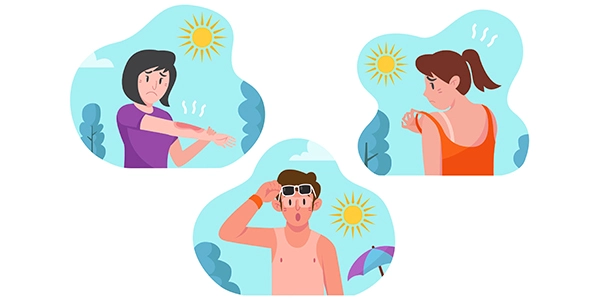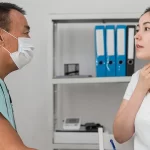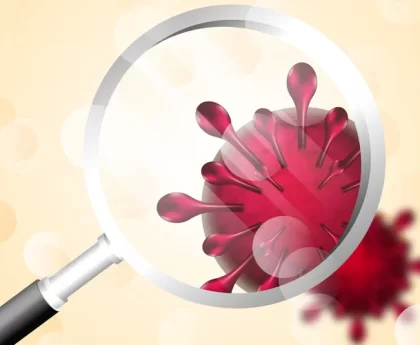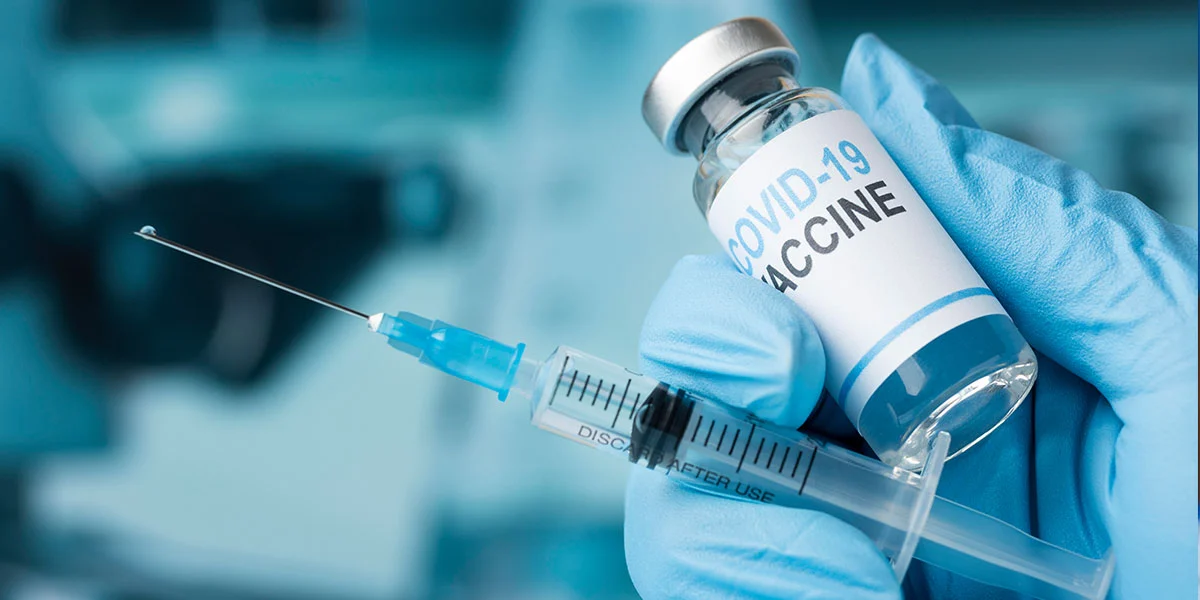Sunburn: is a type of skin damage caused by excessive exposure to ultraviolet (UV) radiation from the sun or other artificial sources like tanning beds. UV radiation can cause harm to the DNA in skin cells, leading to inflammation, redness, pain, and in more severe cases, blistering and peeling of the skin.
The severity of sunburn can vary depending on factors such as the individual’s skin type, the intensity and duration of sun exposure, and the effectiveness of sun protection measures. People with fair skin are generally more susceptible to sunburn compared to those with darker skin tones, as they have less melanin, which provides some natural protection against UV radiation.
Symptoms of Sunburn
Sunburn can cause a range of symptoms that typically appear within a few hours after excessive sun exposure. The severity of these symptoms can vary based on factors like the individual’s skin type, the intensity of the UV radiation, and the extent of exposure.
Common symptoms of sunburn include:
- Redness: Sunburn usually results in reddened and inflamed skin. The degree of redness can vary depending on the severity of the burn.
- Pain and Discomfort: Sunburned skin is often painful, tender, and sensitive to touch. This pain can range from mild to severe.
- Swelling: The affected area may become swollen, especially if the sunburn is more severe.
- Heat: Sunburned skin may feel warmer to the touch compared to surrounding skin.
- Itching: Sunburned skin can be itchy as it starts to heal. However, scratching can worsen the irritation and potentially lead to infection.
- Peeling: A few days after the initial sunburn, the affected skin may start to peel as it attempts to repair itself. Peeling can last for several days.
- Blisters: In severe cases of sunburn, blisters may develop. These can be painful and increase the risk of infection if they break.
- Fatigue and Flu-like Symptoms: Severe sunburn can lead to systemic symptoms like fatigue, headache, fever, and nausea. This is more common in cases of extreme sun exposure.
It’s important to note that sunburn is an indication of damage to the skin cells caused by UV radiation. Repeated sunburns over time can significantly increase the risk of skin cancer and premature aging of the skin. If you experience severe symptoms, such as blistering, intense pain, or flu-like symptoms, it’s advisable to seek medical attention.
To prevent sunburn, it’s crucial to take precautions such as applying sunscreen, wearing protective clothing, seeking shade, and avoiding prolonged sun exposure, especially during peak hours. If you do get sunburned, providing appropriate care and allowing your skin to heal is important to minimize discomfort and potential long-term effects.
Causes of Sunburn
Sunburn is primarily caused by exposure to ultraviolet (UV) radiation from the sun or other artificial sources. The sun emits three types of UV radiation: UVA, UVB, and UVC. UVC radiation is largely absorbed by the Earth’s atmosphere and doesn’t reach the surface. UVA and UVB radiation, however, can penetrate the atmosphere and reach our skin, leading to sunburn and other skin damage.
Here’s how these types of UV radiation contribute to sunburn:
- UVB Radiation: UVB rays are responsible for causing most of the sunburn cases. They penetrate the outermost layer of the skin (epidermis) and directly damage the DNA of skin cells. This damage triggers the body’s inflammatory response, leading to redness, pain, and swelling associated with sunburn.
- UVA Radiation: UVA rays penetrate deeper into the skin, reaching the second layer (dermis). They are less likely to cause immediate visible signs of sunburn, but they contribute to long-term skin damage, including premature aging and an increased risk of skin cancer.
- Several factors can influence the likelihood and severity of sunburn:
- – Skin Type: People with fair skin have less melanin, the pigment that provides some natural protection against UV radiation. As a result, they are more susceptible to sunburn.
- – Sun Exposure: Spending excessive time in the sun without protection increases the risk of sunburn. This is particularly true during peak sun hours (usually from 10 a.m. to 4 p.m.).
- – Altitude: UV radiation becomes more intense at higher altitudes due to decreased atmospheric filtration.
- – Reflective Surfaces: Snow, sand, water, and other reflective surfaces can amplify UV radiation exposure by reflecting it onto the skin.
- – Medications and Skin Sensitivity: Some medications and skin products can increase sensitivity to UV radiation, making sunburn more likely even with shorter exposure.
- – Geographic Location: UV radiation levels vary depending on location, with closer proximity to the equator generally leading to higher UV intensity.
- – Cloud Cover: Clouds can filter out some UV radiation, but it’s important to note that significant UV radiation can still penetrate cloud cover.
To prevent sunburn, it’s crucial to take protective measures like wearing sunscreen with a high SPF, wearing protective clothing, seeking shade, and avoiding prolonged sun exposure. Sunburn not only causes immediate discomfort but can also have long-term consequences for skin health, including an increased risk of skin cancer and premature aging.
Prevention of Sunburn
Preventing sunburn is essential for maintaining healthy skin and reducing the risk of skin damage, premature aging, and skin cancer.
Here are some effective strategies to prevent sunburn:
- Apply Sunscreen: Use a broad-spectrum sunscreen with an SPF (sun protection factor) of 30 or higher. Apply it generously to all exposed skin, including your face, neck, ears, and hands. Reapply every two hours or more frequently if you’re sweating or swimming.
- Seek Shade: Whenever possible, stay in the shade, especially during peak sun hours (usually from 10 a.m. to 4 p.m.). Shade provides natural protection from the sun’s intense UV rays.
- Wear Protective Clothing: Wear lightweight, long-sleeved clothing and wide-brimmed hats to cover your skin. Look for clothing labeled with UPF (ultraviolet protection factor) to ensure added sun protection.
- Protect Your Eyes: Wear sunglasses with UV protection to shield your eyes from harmful UV radiation. This can also help prevent eye damage and discomfort.
- Avoid Tanning Beds: Tanning beds emit UV radiation that can cause skin damage and increase the risk of skin cancer. It’s best to avoid them altogether.
- Stay Hydrated: Drink plenty of water to help your body stay hydrated and manage the effects of sun exposure on your skin.
- Use Lip Balm: Apply a lip balm with SPF to protect your lips from sunburn and potential skin damage.
- Be Cautious Near Water and Snow: Water, snow, sand, and other reflective surfaces can amplify UV radiation. Take extra precautions when you’re near these surfaces.
- Apply Sunscreen Early: Apply sunscreen about 15-30 minutes before going outside to allow it to absorb into your skin properly.
- Reapply After Swimming or Sweating: Even if a sunscreen is labeled as water-resistant, it’s important to reapply it after swimming or sweating, as these activities can reduce its effectiveness.
- Don’t Forget Cloudy Days: UV radiation can still penetrate cloud cover, so apply sunscreen even on cloudy days.
- Limit Sun Exposure: While spending time outdoors is important for your overall well-being, try to avoid prolonged sun exposure. Take breaks in the shade and be mindful of the time you spend in direct sunlight.
- Check UV Index: Check the local UV index before going outside. This index provides information about the strength of UV radiation, helping you plan your outdoor activities accordingly.
Remember that sunburn is not just a short-term discomfort; it can have long-term effects on your skin health. Consistently following sun protection measures is crucial for preventing sunburn and reducing the risk of skin damage and related health issues.

Home Remedies of Sunburn
While prevention is the best approach to avoiding sunburn, if you do end up with sunburn, there are several home remedies you can try to help alleviate the discomfort and promote healing. Keep in mind that these remedies are meant for mild cases of sunburn. If you have severe sunburn with blisters, extreme pain, or other concerning symptoms, it’s advisable to consult a medical professional.
Here are some home remedies you can consider:
- Cool Compresses: Apply cool, damp cloths or take cool baths to help soothe the burned skin. Avoid using very cold water, as it can shock your skin.
- Aloe Vera: Aloe vera gel is known for its soothing properties. Apply pure aloe vera gel to the sunburned area to provide relief from pain and inflammation. Make sure you’re using 100% pure aloe vera without added fragrances or chemicals.
- Hydration: Drink plenty of water to stay hydrated. Sunburn can cause dehydration, and adequate fluid intake helps your body recover.
- Moisturize: After using cool compresses, apply a moisturizer to help alleviate dryness and peeling. Look for moisturizers with ingredients like aloe vera, chamomile, or hyaluronic acid.
- Oatmeal Bath: Taking an oatmeal bath can help soothe irritated skin. Grind oats into a fine powder and add it to your bathwater. Soak for 15-20 minutes.
- Milk: The proteins in milk can help soothe sunburned skin. Soak a clean cloth in cold milk and apply it to the affected area for 15-20 minutes.
- Tea Bags: Brew black or green tea and let it cool. Apply the cooled tea bags directly to the sunburned skin for relief. The tannins in tea can help reduce inflammation.
- Vinegar: Add a cup of white vinegar to a lukewarm bath and soak for about 20 minutes. Vinegar can help balance the skin’s pH and provide relief.
- Honey: Apply a thin layer of honey to the sunburned area. Honey has natural anti-inflammatory and antimicrobial properties that can help promote healing.
- Over-the-Counter Pain Relievers: Non-prescription pain relievers like ibuprofen or acetaminophen can help reduce pain and inflammation associated with sunburn. Follow the recommended dosage instructions.
- Avoid Harsh Products: Avoid using harsh soaps, exfoliants, or products containing alcohol on sunburned skin, as they can further irritate it.
- Cucumber Slices: Place cool cucumber slices on the sunburned skin. Cucumbers have a high water content and can provide cooling relief.
Remember that these remedies may provide temporary relief, but they don’t replace proper medical care. Severe sunburn or sunburn with complications should be evaluated by a medical professional. Additionally, make sure to protect your skin from further sun exposure while it’s healing to prevent more damage.
How harmful is sunburn?
Sunburn is more than just a temporary discomfort; it can have both short-term and long-term health consequences for your skin. The severity of these consequences depends on factors like the intensity and duration of sun exposure, the individual’s skin type, and the degree of sunburn.
Here’s an overview of how harmful sunburn can be:
- Short-Term Effects:
– Pain and Discomfort: Sunburned skin is painful and sensitive to touch. The discomfort can range from mild to severe.
– Swelling and Inflammation: Sunburn leads to inflammation and redness of the skin. In more severe cases, the affected area might swell.
– Blisters: Severe sunburn can cause blisters to form on the skin. These can be painful and increase the risk of infection if they rupture.
– Dehydration: Sunburn draws fluids to the skin’s surface, leading to dehydration. It’s important to drink plenty of water to stay hydrated.
– Systemic Symptoms: In some cases of severe sunburn, individuals may experience systemic symptoms like fatigue, headache, fever, and nausea. - Long-Term Effects:
– Skin Cancer Risk: One of the most serious long-term consequences of sunburn is an increased risk of skin cancer. UV radiation damages the DNA in skin cells, which can lead to the development of skin cancers like melanoma, basal cell carcinoma, and squamous cell carcinoma.
– Premature Aging: Sunburn accelerates the aging of the skin, causing wrinkles, fine lines, age spots, and a loss of skin elasticity.
– Weakened Immune Response: Repeated sunburns can suppress the immune system’s ability to repair damaged DNA in skin cells, increasing the risk of mutations that contribute to skin cancer.
– Eye Damage: Sunburn can also affect the eyes, leading to discomfort, irritation, and an increased risk of cataracts and other eye conditions.
– Increased Photosensitivity: Sunburn can make your skin more sensitive to sunlight, increasing the risk of future sunburns and skin damage.
It’s important to note that individuals with fair skin, a history of frequent sunburns, and a family history of skin cancer are at a higher risk of experiencing these harmful effects. However, people with all skin types can be affected by sunburn.
To minimize the harmful effects of sunburn, prevention is key. Practicing proper sun protection measures, such as wearing sunscreen, seeking shade, and wearing protective clothing, can significantly reduce your risk of sunburn and related health issues. If you do experience sunburn, it’s important to take appropriate care and allow your skin to heal to minimize both short-term discomfort and long-term consequences.
How to care for sunburn?
Caring for sunburn involves a combination of soothing the skin, relieving discomfort, and promoting healing.
Here’s a step-by-step guide on how to care for sunburn:
- Get Out of the Sun: As soon as you realize you have sunburn, move to a shaded area or indoors to prevent further sun exposure.
- Cool Compresses: Apply cool, damp cloths or take cool baths to help soothe the burned skin. Avoid using very cold water, as it can shock your skin.
- Hydrate: Drink plenty of water to stay hydrated. Sunburn can cause dehydration, so keeping your body hydrated is essential.
- Moisturize: After using cool compresses, gently pat your skin dry and apply a moisturizer to help alleviate dryness and peeling. Look for moisturizers with ingredients like aloe vera, chamomile, or hyaluronic acid.
- Aloe Vera Gel: Apply pure aloe vera gel to the sunburned area. Aloe vera has natural anti-inflammatory and soothing properties that can help reduce pain and inflammation.
- Over-the-Counter Pain Relievers: Non-prescription pain relievers like ibuprofen or acetaminophen can help reduce pain and inflammation associated with sunburn. Follow the recommended dosage instructions.
- Stay Cool and Loose: Wear loose, lightweight clothing to avoid additional irritation to your sunburned skin. Opt for breathable fabrics like cotton.
- Avoid Harsh Products: Avoid using harsh soaps, exfoliants, or products containing alcohol on sunburned skin, as they can further irritate it.
- Avoid Picking or Peeling: It’s important to resist the urge to peel off any skin that’s starting to blister or peel. Picking at your skin can lead to infection and scarring.
- Stay Hydrated: Continue drinking water and staying hydrated, as sunburn can cause dehydration.
- Rest and Recovery: Give your body the rest it needs to heal. Sunburn can be physically exhausting, so getting enough sleep and rest is important.
- Protect Your Skin: While your sunburn is healing, protect it from further sun exposure. Wear protective clothing and seek shade when outdoors.
- Avoid Heat and Hot Water: Avoid exposing your sunburned skin to heat and hot water, as they can worsen irritation.
- Consult a Doctor: If you have severe sunburn with blisters, extreme pain, or other concerning symptoms, consider seeking medical attention. A doctor can provide appropriate treatment and advice.
Remember that healing from sunburn takes time. It’s important to be patient and allow your skin to recover naturally. Taking good care of your sunburned skin can help minimize discomfort, prevent complications, and promote a faster healing process.
Sore Throat, Symptoms, Causes, Prevention & Home Remedies
Dandruff: Types, Symptoms, Causes & Prevention
Dark Circles Under Eyes: Symptoms, Remedies & Prevention
Heart Attack: Types, Symptoms & Prevention
Eye Infections: Symptoms, Causes & Treatment
Vertigo: Causes, Symptoms, Treatment & Preventive
Hair Loss, Types, Symptoms, Prevention & Treatments
Knee Pain, Symptoms, Types & Self Management
If you don’t like this article/post please share your feedback.





